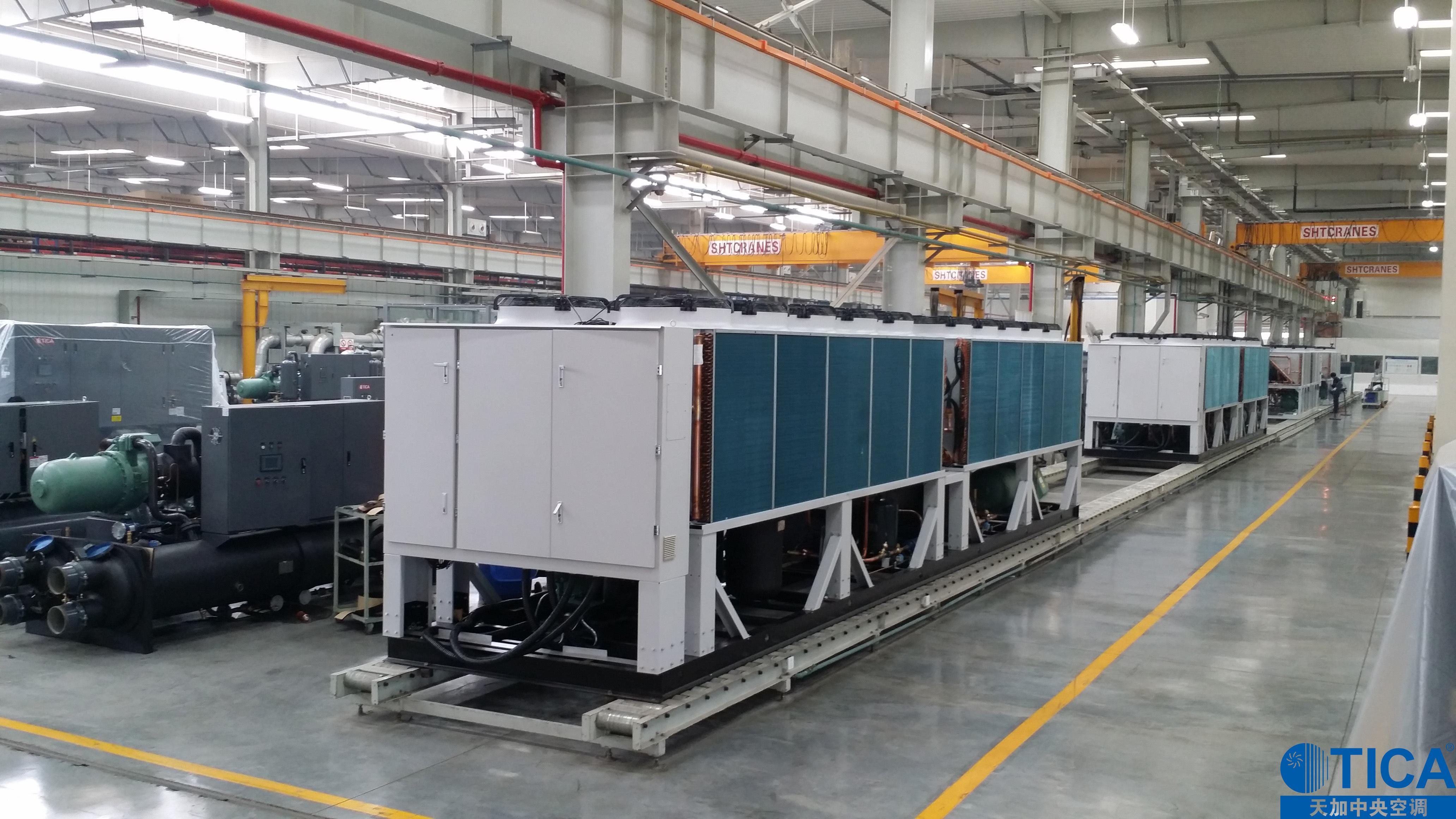Chiller is a refrigerating machine designed for water cooling. Chiller basis operation is the removal of heat from cooled liquid into environment. To remove heat, principle of freon heat exchange is used to remove the heat. Chillers differ in vapor compression and absorption according to operation principle.
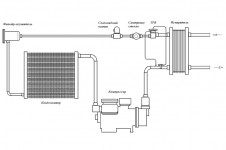 Vapor compression chiller is a chiller where refrigerant (freon) passes from gaseous state to liquid under the pressure created by compressor. Evaporating freon takes heat from cooled water (or water-glycol solution if liquid needs to be cooled below 0°C), after which the gaseous freon enters the compressor, where it compresses into a liquid and transfers heat through the heat exchanger to the environment.
Vapor compression chiller is a chiller where refrigerant (freon) passes from gaseous state to liquid under the pressure created by compressor. Evaporating freon takes heat from cooled water (or water-glycol solution if liquid needs to be cooled below 0°C), after which the gaseous freon enters the compressor, where it compresses into a liquid and transfers heat through the heat exchanger to the environment.
Chillers compressors have two types: sealed (spiral type) and semi-hermetic (piston, screw).
Hermetic compressors are installed in medium and low capacity chillers (up to 250-300 kW), they are have lower cost, compact in size and do not need regular maintenance, but as their design implies a sealed, non-separable housing, in case of failure they are not repairable.
Semi-hermetic compressors have a much larger power range, they are more often used in high-performance chillers (from 300 kW). Such compressors are more expensive, they need to be serviced regularly (change oil and filters), but their design is more durable and even in the event of a breakdown, it is not necessary to change the entire compressor (the compressor is disassembled and the failed part is replaced).
Compressor (from the Latin “compressio” – compression) – a device designed to compress gases through a built-in electric drive or internal combustion engine. Compressors are divided into volume and dynamic.
Volumetric compressors (spiral, screw, piston) – perform gas compression by changing volume of working chamber.
Dynamic compressors (turbochargers) – as a result of mechanical energy supply from the shaft, the turbine blades rotate, which serves to compress the gas.
The principle of Chiller operation.
The chiller consists of a number of elements that are divided into several parts: a compressor unit (chillers with 2-8 scroll compressors work in parallel), a freon evaporator (including a heat exchanger for collecting heat from cooled liquid), a condenser unit, Condensation of compressed Freon and the release of heat into the environment through radiators), housing.
The principle of chiller operation is a recurring closed cycle of freon circulation, which transfers heat from cooled liquid to a hotter environment. Fluid freon enters chiller’s evaporator and during the evaporation caused by sudden expansion, takes heat from cooled liquid (through heat exchanger). Taking the heat from gaseous freon passes into the other part of chiller, compressor pumps freon into the condenser while squeezing it. Hot and compressed Freon is converted into a liquid in condenser, while giving heat to environment through heat sink. After the refrigerant has been liquefied in condenser, freon passes through water separator filter and a solenoid valve, which prevents the liquid refrigerant from entering the compressor when the chiller is turned off. After valve, a sight glass is installed to monitor the amount of Freon in the chiller and a Thermo-Regulating Valve (TRV), which controls the amount of Freon passing into the chiller’s evaporator.
For a vapor compression chiller, tightness of freon loop is important, as when a moisture or incompletely evaporated freon enters the compressor, a compressor breakdown is inevitable.
Steam-compression chillers differ by cooling the condenser and placing the chiller.
- Chiller with condenser, cooled by air flow (installed outdoors):
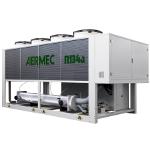
Chillers with this type of condenser cooling are installed in an open area in front of building or on its roof. So, how street air blown by fans through condenser radiator is used to cool the condenser – a large open space is required for intake and exhaust of air.
The main advantage of such chillers is the relatively low cost and simplicity of design.
The drawbacks include need to drain water from цштеук system in the winter – water freezes in the heat exchanger of an unused chiller, destroying it. This disadvantage can be eliminated using a special antifreeze instead of water, but antifreeze is not suitable for some types of equipment that cools the chiller.
- Chiller for indoor installation, equipped with air-cooled condenser and ducts, air comes from the street:
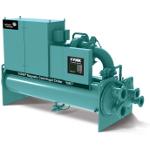
Chillers of this type have complex engineering system installed inside of the building. For its operation, special air ducts are needed, where cool outdoor air enters the building, which passes through condenser radiator, diverting heat from freon; As well as ducts that drain air from the building.
The main disadvantage of such chillers is the difficulty of chiller mounting such. It is required to develop a detailed design not only the hydraulic system, but also the ventilation system. The number and complexity of installation work itself is also very high.
Advantages include the absence of outdoor units, and accordingly, no need to preserve chiller for winter period (draining water from system, sealing the system, etc.).
- Chiller with water cooled condenser:
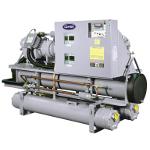
Chillers with water cooled condenser designed for installation indoors. Condenser of refrigerating machine is cooled by an intermediate coolant, which in turn is cooled in cooling towers or flowing coolant.
The advantage of water cooled chiller is ability to organize year-round operation with free cooling, which significantly reduces power consumption. Chillers of these models enable the recovery of condensation heat.
The disadvantages include the high cost and complexity of operating system.
- The capacitor is used as a remote outdoor unit, cooled by air flow:
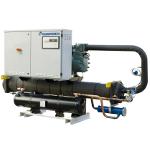
The chiller with an external air-cooled condenser is usually made on the basis of a water cooled chiller. It is placed indoors, connected with condenser of outdoor installation by system of freon wires.
The advantages of chiller with an external condenser for air cooling include the possibility of using it without an intermediate coolant in capacitor circuit. As a consequence, there is no need to use large-capacity circulation pumps. There is no risk of coolant freezing, which does not require the use of a dual circuit cooling system. An important condition for correct operation of this type of chiller is the installation of a liquid receiver that serves as a refrigerant battery.
The chillers of this version have almost no flaws, but it makes sense to include a limited distance between compressor-evaporator and chiller condenser unit.
Heat pump (reversible chiller).
A number of chiller models can be supplied by manufacturer with ability to work in the reversible chiller mode, otherwise called a heat pump. This mode allows you to use the chiller for air heating. Each reversing chiller circuit has a 4-way reversing valve, a receiver for accumulating excess refrigerant, depending on operating conditions, check valves, a liquid separator and an intermediate heat exchanger on suction line. For chillers operating in heat pump mode, it is also necessary to select an additional hydronic module. Source of chiller energy operation in heat pump mode besides air can also be soil heat, water in well, geothermal water.
Here you can buy a steam compression chiller in Uzbekistan. There are models of various capacities (from 10 kW to 130 kW) with a built-in heat pump and without it. Call us for more details.

